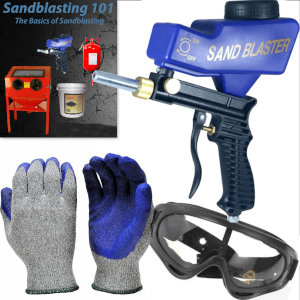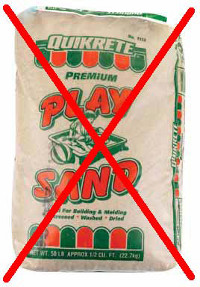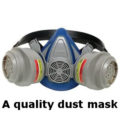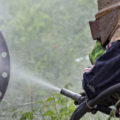Sand is available everywhere, it’s plentiful, and cheap. So can I use it?

Let’s face it. Sandblasting abrasive can be expensive when using the approved type, and regular sand is so incredibility abundant in places like the sand dunes shown in the photo. The photo of this enormous sand dune by the way is from a weekend vacation I took in late 2010 summer. The place is called Warren Sanddunes or Warren Dunes National Park which is located in Michigan. If you ever get a chance, go check them out. Michigan has quite a few different dunes to visit which border the lake.
When I went to this place, it made me think about how amazing it would be use some of this sand for my sandblaster. I would never have to worry about wasting or buying abrasive again!
I have heard that some people that live near sand beaches will actually use the sand for their sandblasting equipment. Well, the whole point of this blog post is to show you how cool these dunes are, but then to express that you shouldn’t use this type of sand even if it is so plentiful.
As I talked about before, regular sand has a lot of silica in it and can cause a serious hazard to your lungs known as silicosis. Some might think that if you wear professional air provided sandblasting helmets, that you will be okay but I am still saying that you should not risk it. Even if you wear the best breathing apparatus out there, you’re still going to get exposed to some silica. If you take off your helmet, you will still have dust fall off your clothing and helmet, then breathed in when you inhale. Don’t do it. I’m just looking out for my fellow man or woman!
Saving a few bucks here and there isn’t worth putting your life into jeopardy.








So then hanging out at the beach then too is hazardous to your health according to your analysis. I live in the desert south west, I am going to use sand from the Colorado river and I see no problem with that do you?
@ Peter, I think you may have misunderstood me, at least that is what I am guessing. This blog is about using a sandblaster machine and I was simply explaining that it isn’t healthy to blast with your sandblaster. Using sand of course isn’t hazardous for playing in, construction and landscaping projects.
Sorry I sounded like a wise guy it was not my intention too, I just needed to know if it was safe to use desert sand in my new sand blaster from Harbor Freight. I don’t see any problem with doing so I have the proper safety equipment. Thank You for your help and sorry for any miscommunications.
@Peter, no worries. Yes, I definitely agree it can be used, especially with proper safety attire . This is just a recommendation not to use it and could be a liability issue for me if I did recommend it to others. In fact I have came under fire from some other subscribers to my website in the industry for using the term “Sand” with blasting which lead me to write this post: https://www.sandblasterinfo.com/term-sandblasting-not-used/
I believe it is OSHA that doesn’t allow businesses to sell it for blasting and requires a note on bags of play sand that it must not be used for blasting, if I recall correctly.
If I had access to an abundant source like you do, I probably would use it, but I wouldn’t go near using it without an air supplied helmet. Without proper safety taken, the money saved wouldn’t outweigh the potential health issues in my mind. A few hundred or even a few thousand dollars in purchasing proper blasting abrasive sure is much cheaper than the health care costs that might rise from silicosis.
Of course, short term use of sand probably isn’t as big of a deal than someone blasting often.
Thank you…
Can I use beach sand for wet sand blasting?
@Rex, great question. Wet sandblasting should prevent a lot of the silica dust from being kicked up and inhaled. In that case, I think it would be fine but I still won’t recommend it just for liability issues and it depends on the water to abrasive ratio, I suppose.
Would Red River Sand from Louisiana work for Wet Sand Blasting? I am looking at a complete older potable sand blaster with compressor. Where would I get enough Soda (this outfit has a 300# Hooper)??
I live @ the beach so I had the same question, “why can’t I use beach sand?” I made a sand blasting box, so all the sand and dust is contained. I can easily let it sit and the dust die down before opening it. The black “sand” (looks like lava rock) that came with the blaster is awful. It doesn’t abrade well, it’s filthy, the dust is a mess (that’s got to be hazardous to you lungs as well) and you can’t reuse it because it’s even less abrasive the 2nd time around. SO, i don’t really want to buy and use that stuff leaving me with no alternative but to use beach sand.
I am sandblasting hundreds of glass pebbles I made/fired to get the frosted look rather than shiny. Obviously, the black stuff I am trying to use isn’t the ticket. If beach sand isn’t then what is?
@Karen, you can definitely use sand if you’d like and take the precautions. If you want something that would cut quicker and is safer, I suggest using aluminum oxide or silicon carbide. You’ll be able to use it over and over again for a very long time without worrying about changing worn out sand and it’s health risks. However, when glass is frosted/etched, you will still have a little bit of silica dust coming off the glass itself as well.
I learned to blast using sand but switched to aluminum oxide when I got a new cabinet. The dust that is generated is awful! And I feel it can’t be better than sand. Can you tell me why aluminum oxide or silicon carbide is considered safer?
@Mary, I agree- all abrasive dust can be awful for your lungs. Sand just has a considerable amount more silica in it that causes silicosis.
Regardless, it is recommended to use an OHSA approved helmet or dust mask for blasting.
Also, an abrasive with little to no silica can still cause silica dust be emitted from the item being blasted… such as blasting rock, glass, etc
Sand is mainly SiO₂ (silica)
Garnet , a common abrasive used for sand blasting and other abrasive processes is mainly SiO₂ (silica) with other atoms attached.
If you are concerned by the danger of silicosis from blasting processes , your only option is soda blasting
@Paul G, it is up to the person whether they want to risk it. It would probably be fine if sand is blasted in a cabinet with ventilation or have an air supplied helmet.
It is said that sand contains up to 95% silica and garnet is said to contain only 0.1% up to 0.5 % silica. So using sand instead of garnet exposes a person anywhere from 200 to 1000 times the amount of silica.
But saying the limit to only soda is not true. Most abrasive media that is approved for blasting either has little- to no silica in it. So yes, soda but also aluminum oxide, coal slag (has small percentage of silica), garnet (has small percentage of silica), inert crushed glass (has very little silica), steel grit, along with a lot of other materials that are softer but harder than soda.